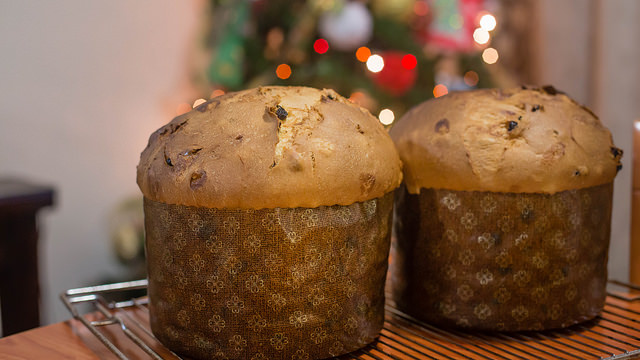Merry Christmas Eve! Welcome to our third and penultimate installment of our mini-series on holiday foods and their origins, linguistic and otherwise.
You’ve already learned about the darling clementine and the Scottish Dundee cake. Today we’re looking at a baked good of the Italian variety: panettone.
You know panettone as those ubiquitous boxes of sweet bread you see piled up pyramid-high in grocery stores. You’ve probably given them and gotten as gifts. But do you know where it comes from?
While Wikipedia says the bread originated in the early 20th century (by “two enterprising Milanese bakers”), the Oxford English Dictionary (OED) cites the Italian panettone, or “fruited loaf,” as coming from Milan in 1831. The earliest recorded usage in English is from 1865: “Biffi Paolo,..Milan.—Panattone (pastry); various kinds of liqueurs.”
It wasn’t until the early 1900s that the bread gained popularity. In 1919, entrepreneur Angelo Motta changed the traditional recipe by “making the dough rise three times,” which gave the bread its now well-known domed shape. A few years later, another baker, Gioacchino Alemagna, adapted the recipe and sold the bread under his own brand. It was the competition between Motta and Alemagna that “led to industrial production of the cake.”
There are a few myths about the origin of the word. One says that panettone derives from the Milanese pan del ton, “cake of luxury.” Another, our favorite, claims it translates as “bread of Toni.”
The Toni in question was a 15th-century Milanese baker with a beautiful daughter. A nobleman was in love with said daughter, and decided to help her by way of her father by posing as a baker and promptly inventing this rich and delicious bread, the bread of Toni. The nobleman married the daughter, and even Leonardo da Vinci was there to give his blessing to the “Pan de Toni.”
The actual origin of the word panettone is far less exciting: it’s an augmentative of the Italian panetto, “small loaf,” which is a diminutive of pane, “bread.” Pane comes from the Latin panis, “bread.” Panem et circuses, also Latin, translates as “bread and circuses” and refers to “offerings, such as benefits or entertainments, intended to placate discontent or distract attention from a policy or situation.”
The Hunger Games’ trilogy takes place in the nation of Panem, where gruesome “games” are held to distract the population from huge class divisions and its totalitarian government. Peeta Mellark, the protagonist’s love interest, is a baker’s son.
[Photo via Flickr, “Homemade Panettone,” CC BY 2.0 by Nicola]
